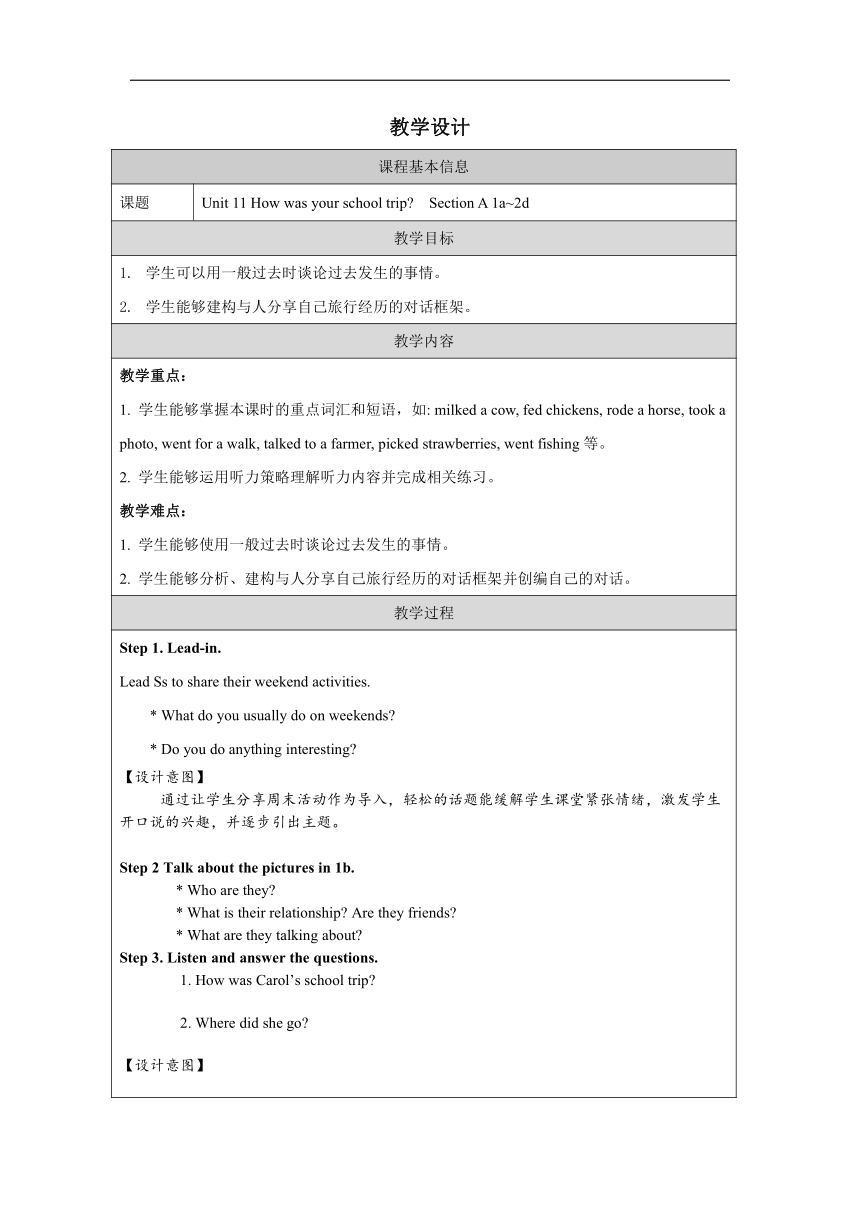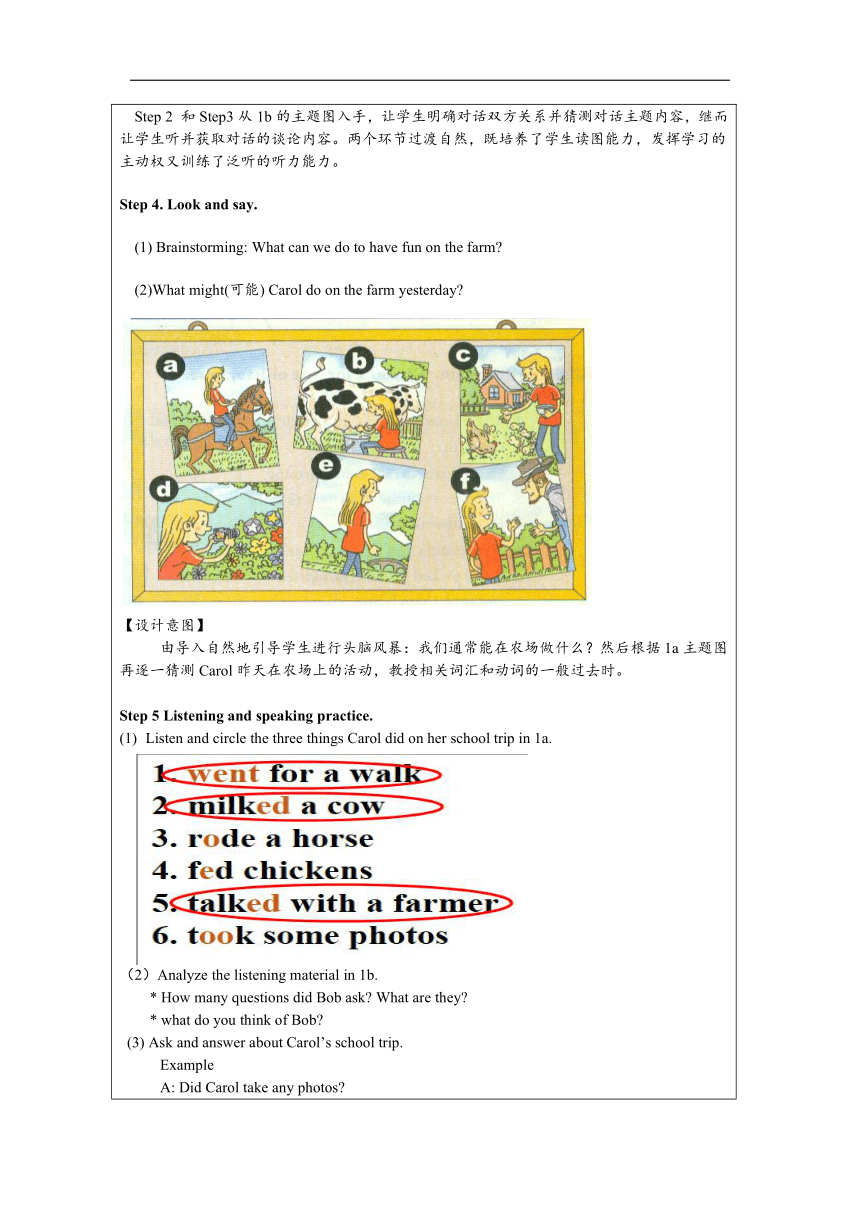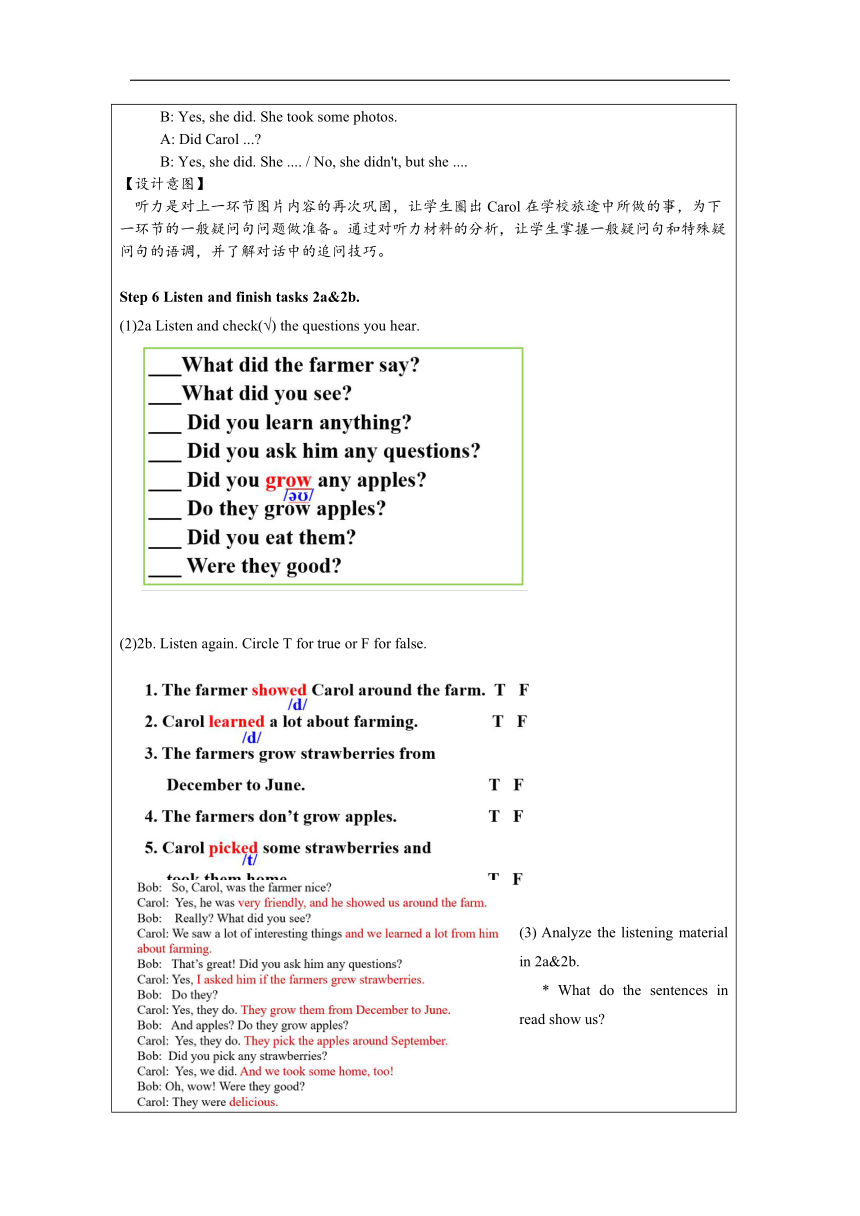Unit 11 How was your school trip Section A 1a—2d 表格式教学设计 人教新目标七年级下册
文档属性
| 名称 | Unit 11 How was your school trip Section A 1a—2d 表格式教学设计 人教新目标七年级下册 |  | |
| 格式 | docx | ||
| 文件大小 | 1000.2KB | ||
| 资源类型 | 教案 | ||
| 版本资源 | 人教新目标(Go for it)版 | ||
| 科目 | 英语 | ||
| 更新时间 | 2024-04-28 14:50:01 | ||
图片预览



文档简介
教学设计
课程基本信息
课题 Unit 11 How was your school trip Section A 1a~2d
教学目标
学生可以用一般过去时谈论过去发生的事情。 学生能够建构与人分享自己旅行经历的对话框架。
教学内容
教学重点: 1. 学生能够掌握本课时的重点词汇和短语,如: milked a cow, fed chickens, rode a horse, took a photo, went for a walk, talked to a farmer, picked strawberries, went fishing等。
2. 学生能够运用听力策略理解听力内容并完成相关练习。
教学难点: 1. 学生能够使用一般过去时谈论过去发生的事情。
2. 学生能够分析、建构与人分享自己旅行经历的对话框架并创编自己的对话。
教学过程
Step 1. Lead-in. Lead Ss to share their weekend activities. * What do you usually do on weekends * Do you do anything interesting 【设计意图】 通过让学生分享周末活动作为导入,轻松的话题能缓解学生课堂紧张情绪,激发学生开口说的兴趣,并逐步引出主题。 Step 2 Talk about the pictures in 1b. * Who are they * What is their relationship Are they friends * What are they talking about Step 3. Listen and answer the questions. 1. How was Carol’s school trip 2. Where did she go 【设计意图】 Step 2 和Step3从1b的主题图入手,让学生明确对话双方关系并猜测对话主题内容,继而让学生听并获取对话的谈论内容。两个环节过渡自然,既培养了学生读图能力,发挥学习的主动权又训练了泛听的听力能力。 Step 4. Look and say. (1) Brainstorming: What can we do to have fun on the farm (2)What might(可能) Carol do on the farm yesterday 【设计意图】 由导入自然地引导学生进行头脑风暴:我们通常能在农场做什么?然后根据1a主题图再逐一猜测Carol昨天在农场上的活动,教授相关词汇和动词的一般过去时。 Step 5 Listening and speaking practice. Listen and circle the three things Carol did on her school trip in 1a. (2)Analyze the listening material in 1b. * How many questions did Bob ask What are they * what do you think of Bob (3) Ask and answer about Carol’s school trip. Example A: Did Carol take any photos B: Yes, she did. She took some photos. A: Did Carol ... B: Yes, she did. She .... / No, she didn't, but she .... 【设计意图】 听力是对上一环节图片内容的再次巩固,让学生圈出Carol在学校旅途中所做的事,为下一环节的一般疑问句问题做准备。通过对听力材料的分析,让学生掌握一般疑问句和特殊疑问句的语调,并了解对话中的追问技巧。 Step 6 Listen and finish tasks 2a&2b. (1)2a Listen and check(√) the questions you hear. (2)2b. Listen again. Circle T for true or F for false. (3) Analyze the listening material in 2a&2b. * What do the sentences in read show us * What are the functions of the words in red Can we use “OK” 【设计意图】 首先,通过完成2a&2b两个听力练习,渗透两个听力策略——听关键信息和听前猜测,同时让学生获取更多可以用来追问的提问方式。然后进行听力材料分析,让学生了解会话时要尽可能分析更多的细节信息和听者要及时进行积极反馈的会话技巧。 Step 7. 2d Role-play the conversation. Look at the picture in 2d and guess: Where were they What did they do (2)Read 2d and fill in the chart. (3)Read and imitate the conversation. 【设计意图】 首先,从图入手,猜测对话的背景,引起学生对于对话内容的期待。再通过一张表格,梳理对话内容与细节信息。最后,通过模仿跟读,训练学生的语言语调,为下面的创编对话作铺垫。 Step 8. Make up a new conversation. (1)Ask Ss to share their last trip during the national holidays with partner. (2)Ask Ss to assess their work and give stars on Self-check List. 【设计意图】 最后的大活动让学生在以上对话结构分析的基础上,建构、创编一个新的对话,巩固了本节课所学,是分析理解到实践创新的一个过程。同时评价量表的设置,可以很好地给学生的对话创编提供准则,也可以让学生依据评价表去评价他人的活动,是教—学—评一体化的体现。 Step 9 Homework 【设计意图】 作业的布置很好地体现了分层教学的理念。必做题是对课本上所学的对话和单词的复习巩固,选做题是让学生与外国朋友John在微信上分享最近的学校旅行经历,是语言学习的情景化应用。但是基础不是特别好的同学可以选做,以充分体现分层布置作业的双减要求。 Step 10 Blackboard Design. 【设计意图】 板书的设计上讲究简洁、直观地呈现本节课重点,布局合理。
课程基本信息
课题 Unit 11 How was your school trip Section A 1a~2d
教学目标
学生可以用一般过去时谈论过去发生的事情。 学生能够建构与人分享自己旅行经历的对话框架。
教学内容
教学重点: 1. 学生能够掌握本课时的重点词汇和短语,如: milked a cow, fed chickens, rode a horse, took a photo, went for a walk, talked to a farmer, picked strawberries, went fishing等。
2. 学生能够运用听力策略理解听力内容并完成相关练习。
教学难点: 1. 学生能够使用一般过去时谈论过去发生的事情。
2. 学生能够分析、建构与人分享自己旅行经历的对话框架并创编自己的对话。
教学过程
Step 1. Lead-in. Lead Ss to share their weekend activities. * What do you usually do on weekends * Do you do anything interesting 【设计意图】 通过让学生分享周末活动作为导入,轻松的话题能缓解学生课堂紧张情绪,激发学生开口说的兴趣,并逐步引出主题。 Step 2 Talk about the pictures in 1b. * Who are they * What is their relationship Are they friends * What are they talking about Step 3. Listen and answer the questions. 1. How was Carol’s school trip 2. Where did she go 【设计意图】 Step 2 和Step3从1b的主题图入手,让学生明确对话双方关系并猜测对话主题内容,继而让学生听并获取对话的谈论内容。两个环节过渡自然,既培养了学生读图能力,发挥学习的主动权又训练了泛听的听力能力。 Step 4. Look and say. (1) Brainstorming: What can we do to have fun on the farm (2)What might(可能) Carol do on the farm yesterday 【设计意图】 由导入自然地引导学生进行头脑风暴:我们通常能在农场做什么?然后根据1a主题图再逐一猜测Carol昨天在农场上的活动,教授相关词汇和动词的一般过去时。 Step 5 Listening and speaking practice. Listen and circle the three things Carol did on her school trip in 1a. (2)Analyze the listening material in 1b. * How many questions did Bob ask What are they * what do you think of Bob (3) Ask and answer about Carol’s school trip. Example A: Did Carol take any photos B: Yes, she did. She took some photos. A: Did Carol ... B: Yes, she did. She .... / No, she didn't, but she .... 【设计意图】 听力是对上一环节图片内容的再次巩固,让学生圈出Carol在学校旅途中所做的事,为下一环节的一般疑问句问题做准备。通过对听力材料的分析,让学生掌握一般疑问句和特殊疑问句的语调,并了解对话中的追问技巧。 Step 6 Listen and finish tasks 2a&2b. (1)2a Listen and check(√) the questions you hear. (2)2b. Listen again. Circle T for true or F for false. (3) Analyze the listening material in 2a&2b. * What do the sentences in read show us * What are the functions of the words in red Can we use “OK” 【设计意图】 首先,通过完成2a&2b两个听力练习,渗透两个听力策略——听关键信息和听前猜测,同时让学生获取更多可以用来追问的提问方式。然后进行听力材料分析,让学生了解会话时要尽可能分析更多的细节信息和听者要及时进行积极反馈的会话技巧。 Step 7. 2d Role-play the conversation. Look at the picture in 2d and guess: Where were they What did they do (2)Read 2d and fill in the chart. (3)Read and imitate the conversation. 【设计意图】 首先,从图入手,猜测对话的背景,引起学生对于对话内容的期待。再通过一张表格,梳理对话内容与细节信息。最后,通过模仿跟读,训练学生的语言语调,为下面的创编对话作铺垫。 Step 8. Make up a new conversation. (1)Ask Ss to share their last trip during the national holidays with partner. (2)Ask Ss to assess their work and give stars on Self-check List. 【设计意图】 最后的大活动让学生在以上对话结构分析的基础上,建构、创编一个新的对话,巩固了本节课所学,是分析理解到实践创新的一个过程。同时评价量表的设置,可以很好地给学生的对话创编提供准则,也可以让学生依据评价表去评价他人的活动,是教—学—评一体化的体现。 Step 9 Homework 【设计意图】 作业的布置很好地体现了分层教学的理念。必做题是对课本上所学的对话和单词的复习巩固,选做题是让学生与外国朋友John在微信上分享最近的学校旅行经历,是语言学习的情景化应用。但是基础不是特别好的同学可以选做,以充分体现分层布置作业的双减要求。 Step 10 Blackboard Design. 【设计意图】 板书的设计上讲究简洁、直观地呈现本节课重点,布局合理。
同课章节目录
- Unit 1 Can you play the guitar?
- Section A
- Section B
- Unit 2 What time do you go to school?
- Section A
- Section B
- Unit 3 How do you get to school?
- Section A
- Section B
- Unit 4 Don't eat in class.
- Section A
- Section B
- Unit 5 Why do you like pandas?
- Section A
- Section B
- Unit 6 I'm watching TV.
- Section A
- Section B
- Review of Units 1-6
- Unit 7 It's raining!
- Section A
- Section B
- Unit 8 Is there a post office near here?
- Section A
- Section B
- Unit 9 What does he look like?
- Section A
- Section B
- Unit 10 I'd like some noodles.
- Section A
- Section B
- Unit 11 How was your school trip?
- Section A
- Section B
- Unit 12 What did you do last weekend?
- Section A
- Section B
